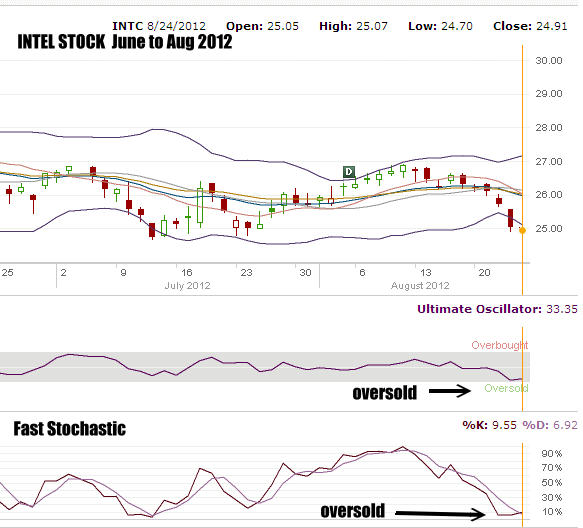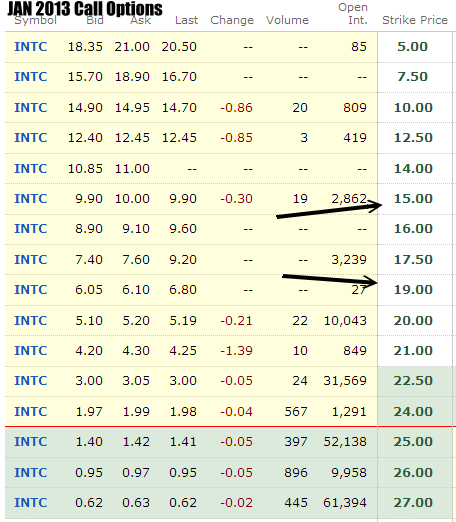This week my Put Selling trades on Intel Stock has created the largest position I have taken in Intel Stock. In the past I have taken larger positions through Put Selling other stocks including Coca Cola Stock, Johnson and Johnson Stock, PepsiCo Stock and YUM Stock, but presently I have no other stocks with positions as large as Intel Stock. I am currently committing $122,000 including some margin, to my Put Selling trades on Intel Stock. Of that the two largest positions far out of the money are at the $24 and $23 put strikes. These positions are presently using Margin to secure them.
A number of questions have been emailed to me regarding my recent Put Selling on Intel Stock. I thought I would answer them in this article.
Reader Question: Put Selling Intel Stock Why Choose The $26 Put Strike
I started Put Selling against Intel Stock on August 21 as the stock pulled back. While the technical timing indicators continues to show that Intel Stock could fall further, I discussed in my Put Selling Intel Stock article on August 21 how I was setting up my Put Selling strategy for going into the fall of 2012. I am Put Selling in small lots as the stock falls. I then will roll out these options if needed or roll out and down depending on how the trade unfolds.
It is certainly true that I could have waited longer to see where Intel Stock would fall and not sold the $26 strike before Put Selling. But there is never a guarantee in investing as to how far and how long that may take for Intel Stock to reach a new level. I believe there is enough support at $25 in Intel Stock to make the $24, $25 and $26 put strikes compelling enough for Put Selling.
There are also many strategies associated with put selling In The Money Puts which could be applied to Intel Stock.
If I was not interested in owning shares in Intel Stock I would definitely not be Put Selling the $26 put strike. I would wait longer for stock technical analysis to advise that Intel Stock is bottoming from the recent selling and then commencing put selling out of the money puts.
It is important to differentiate between Put Selling against stocks I would own and those I would not. Intel Stock I would own if assigned at $26 and then I would sell covered calls to be exercised out of the stock. My plan however is to roll the $26 strike for a period of time until either the stock recovers or it falls further and I would then roll down lower in strikes. You can read this article here which discusses the rolling options strategy for Intel Stock. Presently my Put Selling in Intel Stock is for income generation.
Reader Question: Put Selling Intel Stock How To Duplicate The Trade With Less Capital
A reader wondered about the total capital required and how he could duplicate my Put Selling trades in Intel Stock with only $25,000 of capital.
To do this simply reduce the number of put contracts being sold. For example I am presently holding:
5 Sept $26 naked puts for .48 cents
5 Sept $26 naked puts for .69 cents
10 Oct $25 naked puts for .50 cents
5 Oct $25 naked puts for .28 cents
10 Oct $24 naked puts for .35
5 Oct $24 naked puts for .52
10 October $23 naked puts for .38
Total income earned = $2103.50
Total Capital In use = $122,585.
Total Put Contracts Sold = 50
To duplicate the trade with a lot less capital, reduce the put contracts when you do put selling. An example might look like this:
3 Sept $26 naked puts for .50 cents
3 Oct $25 naked puts for . 50 cents
2 Oct $24 naked puts for .52 cents
2 Oct $23 naked puts for .38 cents
Total Income Earned = $480.00
Total Capital In Use = $24700
Total Put Contracts Sold = 10
Income = 1.9%
From this duplicate position you can set up a rolling strategy for many months to come. Eventually you will want to let those positions expire that are out of the money. If Intel Stock should fall then you would set up a rolling strategy such as in my Put Selling Intel stock rolling options article.
By rolling these options monthly the goal would be to earn 1% a month with the rolls or 12% for the year. Remember that I have a lot of available cash which I plan to use for more Put Selling if there is more selling in the coming weeks in the stock market or my favorite stocks. With just $25,000 available for this trade you could easily commit an additional $12,500 or 50% in Put Selling by using the margin available against your original $25,000 invested. In this manner only an extreme event which collapsed the stock markets and pushed Intel Stock below $15.00 would end up giving a margin call.
This brings me to my next question from a reader.
Reader Question: How To Safely Use Margin When Put Selling Intel Stock
When using margin in put selling, calculate out a reasonably low level in the stock then use 55% of that to protect yourself from a margin call. Using all your available margin is a recipe for disaster should the market take a quick dive. Any close in prices that leaves your position below margin limits will mean a margin call. In some brokerages they can sell positions without notifying the investor. Many discount brokerages are set up in this manner so watching available margin is important. For example, if I had sold 10 naked puts for Intel Stock at $26.00 I would be required to have available $26,000 in cash and margin to pay for any possible assignment.
If the stock was at $26.00 my margin amount available will be higher than if the stock was at $20.00. Exact margin available fluctuates daily with different firms and your portfolio value, but if Intel Stock fell to $20.00 your value in that stock is down to $20,000.00. Your margin amount with many brokerages would be about $14,700.
Instead consider using the 55% rule for margin use which is what I use when using margin for Put Selling. Pick a low level in Intel Stock from the past 12 months. It has been at $20.00 over the past 12 months so depending on your outlook for Intel Stock that could be a good starting point. If your stock fell to $20.00 you could easily use $11,000.00 in margin for Put Selling and not expect to have a margin call unless Intel Stock fell to around $16.00.
By arbitrarily picking a low price level for the past 12 months and multiplying it by the number of shares you are holding then dividing it by 55% you can get some idea as to how much margin you may have available for Put Selling. At 55% you will be far below what your brokerage is allowing you, making it fairly safe to use that amount of margin when Put Selling without worry about a margin call. Remember though check your margin amount each day as it will fluctuate with your positions.
In my Intel Stock for example, I have cash held back for 10 of the $26 strike, 15 of the $25 strikes and for 5 of the $24 strike. This is a total of 3000 shares of Intel Stock. This totals $75,500.00 of cash. If Intel Stock fell to $20.00 my valuation of my 3000 shares would be $60,000. 55% of that is $33,000.00
I am holding 10 naked puts at the $23 strike and 5 naked puts at the $24 strike. Total margin in use then is $35,000.00. I am just over the 55% threshold I like to work from. Remember that margin is based on your total portfolio held by the brokerage which is why when I use margin for Put Selling I prefer to stay at 55% and calculate from low prices from the last 12 months. That way the chance of having a margin call when put selling is greatly reduced unless there is a severe and sudden crash.
This is important because if stocks pull back for only a day or two and then came roaring back, you may find your Put Selling has placed naked puts that were out of the money and profitable, into the money and into a loss position. If you have a margin call which you are unaware of, the brokerage may lock in losses when they sell off or buy to close naked put positions. These same positions may have ended up being profitable a few days later when the market rebounded.
Reader Question: Aren’t You Asking To Be Assigned By Selling the $26 Put Strike
I thought it best to include the actual question from this reader in order to understand it.
“I recently discovered your website and enjoy it immensely. In the recent Intel put article you mention selling $26 In The Money Puts Options eventhough you think it will decline. I understand the$25 puts, but $26 seems like begging to be assigned. Wouldn’t you lose money buying them back to avoid assignment?”
The short answer would be that I didn’t sell the $26 puts figuring I would buy them back for a loss. It is part of an overall strategy on Intel Stock and Put Selling. I could conceivably be put selling the in the money puts at the $26 strike for months, earning income and avoiding assignment of shares through a strategy of rolling the $26 in the money puts options.
The stock will most certainly fluctuate up and down over the coming months. This makes for good opportunities to buy and sell the $26 naked puts a number of times.
A lot of the reasoning behind selling in the money puts depends on the goal of the investor. In my case I would be happy to be assigned shares at $26 even though I feel $25 is more fairly valued. But if assigned Intel Stock at $26, I could sell in the money covered calls which would also be profitable and assist in being exercised from my Intel Stock to restart the process. But one thing is important to understand and that is that Put Selling rarely sees early assignment of stock.
Put Selling Rarely Sees Early Assignment
It is important to understand that Put Selling is actually different from covered calls although many options traders would argue this point. One of the areas they differ is in early assignment of shares. Even when Put Selling deep in the money puts I have rarely been assigned shares prior to options expiry. This is not the case with Covered Calls. Once my covered calls fall in the money I have to do my utmost to avoid assignment. This means rolling early and watching out for dividend payouts which are often a cause for early exercise of covered calls.
By put selling in the money puts at $26 on Intel Stock, I am not asking to be assigned until I am ready to accept assignment. That is one of the great things about Put Selling. Once the puts are sold I am in charge of the position from beginning to end. It is rare to be assigned shares early when Put Selling a stock.
Reader Question: Using Other Options Strategies On Intel Stock As It Sells Off
This reader wondered about other options strategies beside Put Selling for Intel Stock. There are literally dozens. In the present sell-off in Intel Stock, credit spreads, either bull or call would work depending on your outlook for Intel Stock. Verticals would also be an option trade worth considering. I do not believe a straddle or strangle is the best choice as of Friday August 24 2012 and I would not be a buyer of put options now. Instead looking at the chart below on Intel Stock I would be a buyer of call options over put options, but options are a wasting asset and buying put and call options rarely interests me which is why I sell options.

Intel Stock for June to August 2012.
Looking at the chart above, Intel Stock looks ready to bounce. Perhaps buying calls would be a decent option trade to consider instead of put selling. If buying call options I would be tempted to go out two months but they are not cheap.
Another strategy if you are convinced that Intel Stock is going to rise would be to buy a deep in the money covered call on Intel Stock. Below are January 2013 Call Options. An investor who thinks Intel Stock could climb may want to hedge a bit and buy the January $15 or $19 call option in lieu of owning Intel Stock.
The January $15 call option can be bought for $10.00 on Friday which would create a synthetic stock position placing your cost for the stock at $25.00. On Friday Intel Stock closed at $24.91, so basically this call option is only costing .07 cents. If the stock moves higher the January $15 call will follow the stock higher but it will cost the investor less. Come January if the stock is above $15.00 an investor can exercise the $15 options and own the stock for $15.00 at that time.
The January $19 call options would cost $6.10 on Friday for a cost of $25.10. Basically creating a stock synthetic position means that this call option places an investor into the stock at a premium of only $25.10 less $24.91 = .19 cents. Just like the $15 covered call, if Intel Stock moves higher the $19 call option will track the rise in the stock. This is a pretty easy way to follow the stock higher and profit from any bounce in the stock without laying out as much capital to the trade.

January 2013 Intel Stock Call Options
It could also be turned into a credit spread by selling out of the money call options. For example, buying the January $15 call for $10.00 and selling the January $27 call, caps the return to just $27.00 but reduces the cost of the trade by .62 cents.
Intel Stock Covered Calls
Another simple trade in lieu of Put Selling would be to buy Intel Stock on Friday at $24.91 and sell a covered call, possibly out to January $25 for $1.40. There is a dividend payout in early November for .225 cents, so the total return on an at the money covered call for Jan 2013 at $25 would be $1.715 or 6.8%.
The return from covered calls can be adjusted up or down by the decision of what call strike to sell. An in the money covered call on Intel Stock will provide a smaller return but better protection and an out of the money covered call will provide a better return if exercised but less protection. It all depends on the investor and his goals as well as outlook for Intel Stock.
Personally I prefer Put Selling but there are lots of different strategies which can be applied to Intel Stock at this point in time.

